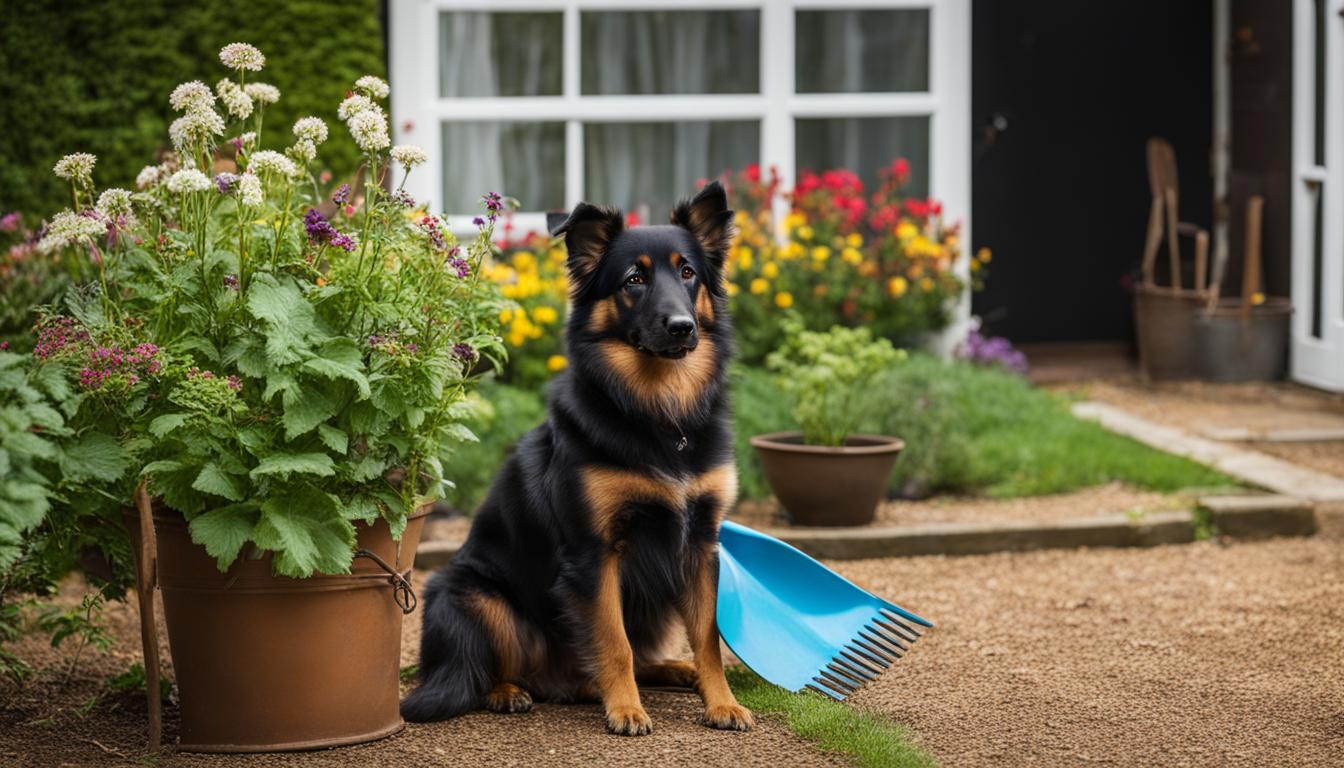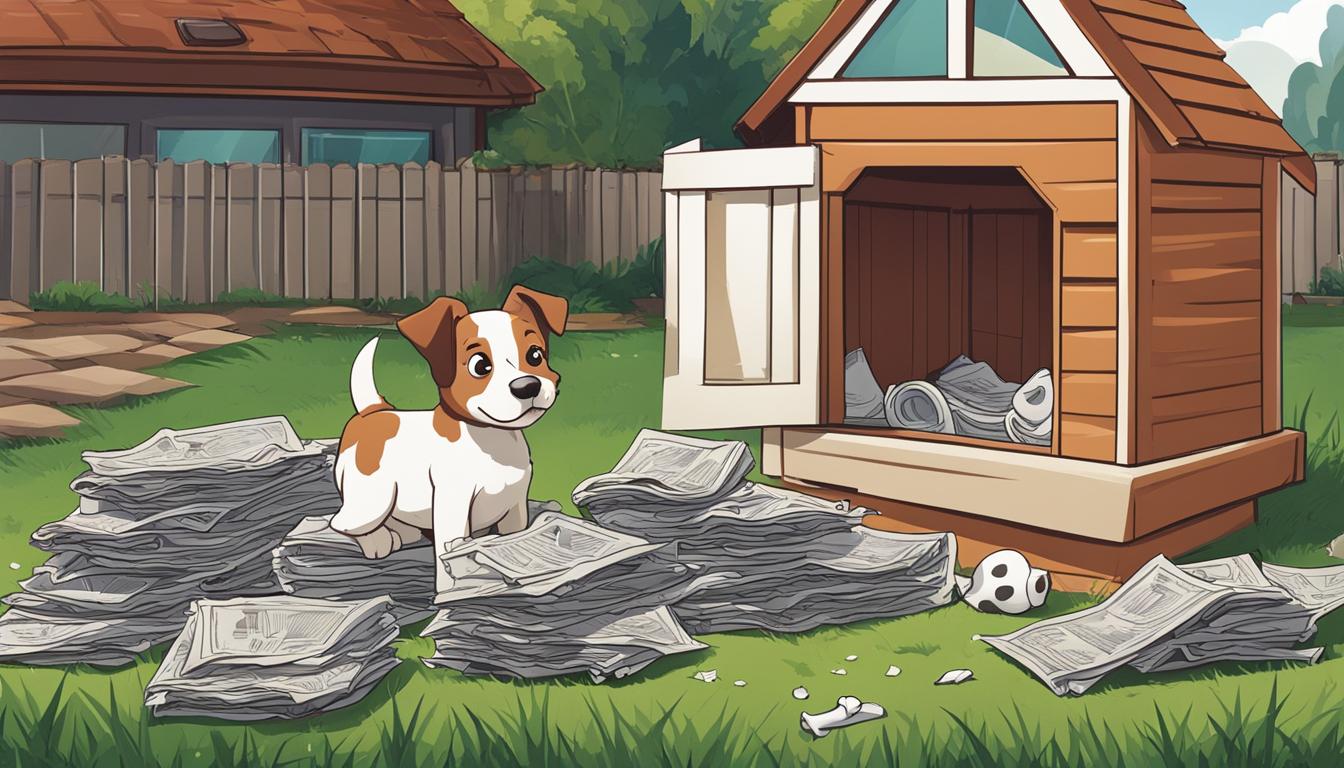Is your furry friend turning your garden into a war zone? Are you tired of constantly patching up the holes in your lawn? Don’t worry, we’ve got you covered. In this article, we’ll delve into the fascinating world of dog digging behavior and explore effective solutions to prevent garden digging in dogs and keep your lawn intact.
Key Takeaways:
- Dog digging behavior can stem from boredom, hunting instinct, or emotional distress.
- Understanding the specific motivation behind the digging is crucial for finding appropriate solutions.
- Providing ample exercise, mental stimulation, and a designated digging area can redirect your dog’s focus.
- Alternative outlets for energy, interactive toys, and a stress-free environment can help reduce digging urges.
- Consider safe digging alternatives and targeted techniques based on your dog’s breed tendencies.
Understanding the Reasons Behind Dog Digging
When it comes to addressing your dog’s digging behavior, it’s essential to understand the underlying motivations behind this common canine activity. Dogs may dig for various reasons, such as play and entertainment, hunting instincts, or even trying to assist with your gardening activities. Additionally, digging can be a response to boredom, separation anxiety, or fear. By pinpointing the specific reason behind your dog’s digging behavior, you can develop the most suitable solution.
If your dog digs for play or entertainment, providing alternative outlets for their energy can be helpful. Engage in regular play sessions, offer stimulating toys, and provide training exercises to keep their minds occupied. Boredom-related digging can often be managed by introducing new activities or rotating their toys to keep things fresh and exciting.
For puppies, digging is a natural behavior that often stems from curiosity. To cope with digging in puppies, it’s crucial to redirect their focus to appropriate areas. Set up a designated digging spot filled with loose dirt where they can satisfy their urge to dig without causing damage to your yard or garden. Encourage them to dig in this area by burying toys or treats to capture their interest.
| Possible Reasons for Dog Digging | Appropriate Solutions |
|---|---|
| Play and entertainment | Provide alternative outlets for energy and mental stimulation, such as regular play sessions and interactive toys. |
| Hunting instincts | Engage in activities that mimic hunting, such as puzzle toys or scent games, to redirect their focus. |
| Assisting with gardening | Create a designated digging area with loose dirt where they can help out without causing damage. |
| Boredom-related digging | Introduce new activities, rotate toys, and ensure your dog receives enough mental and physical stimulation. |
| Puppies | Set up a designated digging spot and encourage them to dig there by burying toys or treats. |
Redirecting and Managing Dog Digging Behavior
When it comes to dealing with dog digging behavior, redirecting their energy and providing alternative outlets is key. By engaging your dog in regular exercise, play sessions, and training exercises, you can help reduce their boredom-induced digging tendencies. Not only will these activities keep them physically stimulated, but they will also provide mental enrichment, decreasing the likelihood of them resorting to digging as a form of entertainment.
To further discourage digging, creating a designated digging area can be highly effective. This area should be filled with loose dirt or sand and can be easily identified by using a different texture or marking it with a fence or boundary. Encourage your dog to dig in this specific area by burying toys or treats, providing positive reinforcement for their appropriate behavior.
In addition to redirecting their energy and creating a designated digging area, it’s important to create a stress-free environment for your dog. Dogs may resort to digging as a means to alleviate stress or anxiety. Identifying and addressing the underlying causes of their stress can help reduce their digging behavior. Implementing behavioral techniques, such as positive reinforcement training and desensitization exercises, can also be effective in modifying their behavior and reducing stress-induced digging.
| Reducing Stress-Induced Digging | Behavioral Techniques Against Digging |
|---|---|
| Identify and address the underlying causes of stress | Utilize positive reinforcement training to redirect their focus |
| Create a calm and predictable environment | Implement desensitization exercises to reduce anxiety |
| Provide comforting and soothing resources, such as a cozy bed or blanket | Consistency and patience are key in reinforcing positive behavior |
Remember, managing dog digging behavior is a process that requires consistency and patience. By providing appropriate outlets for their energy, creating a designated digging area, and addressing any underlying stressors, you can effectively redirect their digging tendencies and guide them towards more desirable behaviors.
Safe Digging Alternatives and Training Techniques
If your dog has a natural inclination to dig, it’s essential to provide them with safe alternatives to redirect their digging behavior. Creating a designated digging area can be an effective solution. Fill this area with loose dirt or sand, making it enticing for your dog to dig. You can even bury toys or treats in this area to encourage their interest and engagement. By offering a designated space for digging, you can protect the rest of your yard or garden from damage.
Training techniques can also play a crucial role in redirecting your dog’s focus away from undesirable digging spots. One effective technique is interrupting the digging behavior. When you catch your dog in the act of digging, calmly and firmly say “no” and redirect their attention to the designated digging area. Reinforce positive behavior by praising and rewarding them when they dig in the right spot. Consistency and patience are key in successfully training your dog to dig in appropriate areas.
Another option to create dig-free zones in your yard is to use barriers or deterrents. For example, you can place rocks or decorative fencing around areas you don’t want your dog to dig. This creates a physical barrier that can discourage digging. Additionally, there are commercial products available that emit odors or tastes that are unpleasant to dogs, making them less likely to dig in certain areas. These deterrents can be effective in protecting specific parts of your yard or garden.
| Dig-Free Zone Options | Pros | Cons |
|---|---|---|
| Designated Digging Area | Redirects digging behavior | Requires training and reinforcement |
| Barriers and Fencing | Physically prevents access to certain areas | May require ongoing maintenance |
| Commercial Deterrents | Provides a deterrent based on taste or odor | May need to be reapplied regularly |
Remember, it’s important to consistently reinforce the training techniques and provide enticing alternatives to prevent your dog from returning to their digging habits. With patience and persistence, you can guide your dog towards more appropriate and acceptable behaviors.
Addressing Digging in Specific Breeds
If you have a terrier or another breed known for their digging instincts, you may be familiar with the challenges of managing their digging behavior. While it can be frustrating, understanding the specific traits and tendencies of your dog’s breed can help you find targeted solutions. By implementing dog digging deterrents and modifying the environment, you can effectively address their digging behavior.
Finding the Right Dog Digging Deterrents
When it comes to addressing digging in specific breeds, using dog digging deterrents can be an effective strategy. There are various options available that can help discourage your dog from digging in unwanted areas. One popular method is using specially designed sprays that have an unpleasant taste or smell to deter your dog from digging. These sprays can be applied to areas of your yard or garden that you want to protect.
“Using dog digging deterrents can be an effective strategy.”
Another option is to create physical barriers to prevent your dog from accessing areas where digging is not allowed. This can include using fencing, chicken wire, or landscaping materials to block off specific parts of your yard. By creating clear boundaries, you can help your dog understand where they are allowed to dig and where they are not.
Modifying the Environment
In addition to using dog digging deterrents, modifying the environment can also be helpful in managing digging behavior. One approach is to create a designated digging area where your dog is encouraged to dig. This area should be filled with loose dirt or sand, making it more enticing for your dog to dig there instead of your garden or lawn.
To encourage your dog to use the designated digging area, you can bury toys or treats for them to find. This will not only redirect their digging behavior but also provide them with a fun and rewarding activity. Consistency is key when training your dog to use the designated area, so be sure to praise and reward them when they dig in the right place.
By implementing dog digging deterrents and modifying the environment, you can effectively manage and reduce digging behavior in specific breeds. Remember, every dog is different, so it may take some trial and error to find the methods that work best for your furry friend. With patience and persistence, you can help redirect their natural digging instincts and create a harmonious living environment.

Conclusion
Dealing with dog digging behavior can be a challenge, but with the right approach, you can find effective solutions. By understanding the motivations behind your dog’s digging, you can address the root cause and guide them towards more appropriate behaviors.
To manage digging behavior, it’s crucial to redirect their energy and provide ample mental stimulation. Engage them in daily walks, play sessions, and training exercises to keep them physically and mentally active. Additionally, creating a designated digging area filled with loose dirt can provide a safe outlet for their natural instincts.
Consistency and patience are key in dealing with dog digging behavior. Remember to reinforce positive behavior, interrupt the digging behavior when necessary, and redirect their attention to the designated digging area. With time and proper guidance, you can help your furry friend overcome their digging habits and enjoy a harmonious relationship with your garden or lawn.
FAQ
Why do dogs dig?
Dogs may dig for various reasons, including boredom, hunting instinct, and seeking relief from emotional distress.
How can I address my dog’s digging behavior?
It’s important to determine the motivation behind the digging behavior to effectively address it. Providing ample exercise, mental stimulation, and a designated digging area can help redirect their focus and prevent damage to your garden or lawn.
What are some reasons dogs dig?
Dogs may dig for play and entertainment, hunting prey, burying and retrieving bones, seeking cool spots, making nests, or trying to assist with gardening activities. Digging can also occur due to boredom, separation anxiety, or fear.
How can I discourage my dog from digging?
To discourage digging, it’s important to provide alternative outlets for your dog’s energy, such as daily walks, play sessions, and training exercises. Keeping them mentally stimulated with interactive toys and engaging activities can also help prevent boredom-induced digging.
What can I do to redirect my dog’s digging behavior?
Offering safe digging alternatives, such as a designated digging box or area filled with loose dirt, can redirect your dog’s digging behavior. Training techniques, like interrupting the digging behavior and providing an alternative, can also be effective in redirecting their focus and reinforcing positive behavior.
Are certain dog breeds more prone to digging?
Some dog breeds, such as terriers, are naturally inclined to dig due to their hunting instincts. Understanding the specific traits and tendencies of your dog’s breed can help in finding targeted solutions.
How can I manage and reduce my dog’s digging behavior?
By redirecting their energy, providing mental stimulation, and creating designated digging areas, you can guide your dog towards healthier and more acceptable behaviors. Consistency and patience are key in successfully managing and reducing dog digging behavior.





